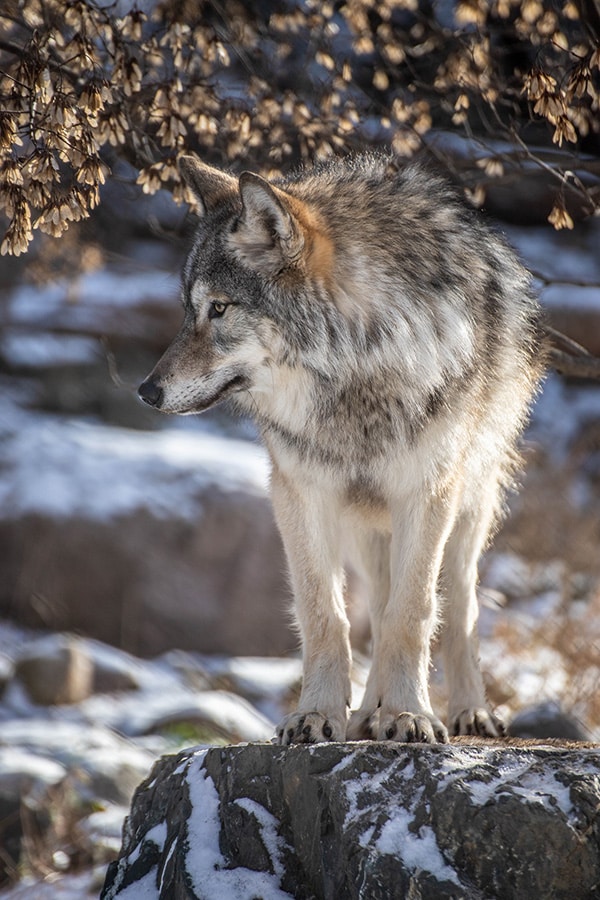Do wolves in different parts of the world have different cultures?
By Joseph K. Bump
 Do wolves from different regions or populations have distinct cultures? It’s an open debate.
Do wolves from different regions or populations have distinct cultures? It’s an open debate.
I don’t mean wolf music, art, or sports customs, but food might be a key cultural difference for some wolves. What about howling – does it have regional differences that depend upon learning and can be trendy, like whale or bird songs? And are humans potentially shaping wolves in ways that favor certain behaviors and, therefore, the development of specific wolf cultures? It’s plausible to think that wolves have cultural differences across their global range, and there are some intriguing observations of behaviors that indicate variation in wolf personalities, a precursor for cultural development.
Animal cultures are a hot topic in ecology and conservation science right now. In fact, my colleagues and I are currently working on a couple of papers for peer review on wolf personalities, carnivore cultures, what they may look like, and why they might matter for conservation. We are not all in agreement yet.
Strictly speaking, animal cultures are consistent differences in behavior between groups or populations that are a consequence of some form of social learning and are not directly caused by environmental factors or genetic differences. Culture comes from socially learned and transmitted information. The best evidence for animal cultures is based on studies of feeding behavior, migration routes, and vocalizations. Primates using tools to forage for insects is a cultural behavior. Bighorn sheep and reef fish learn and transmit their migration routes, creating cultural movements. Bird and whale songs can change and trend across populations and then fall out of favor, replaced by new songs.
These animal culture examples involve behaviors learned and transmitted through social networks. What might that look like in wolves? It might start with behaviors that indicate personality. Personality traits are precursors to cultural development. Through the work of the Voyageurs Wolf Project, we’ve noticed that some wolves are really good at killing beavers and spend a lot of time waiting in ambush for beavers. Other wolves have every bit as much opportunity to kill beavers in the same sorts of ponds and forests, but do not. We’ve made comparisons for wolves that are in the same packs, equivalent ages, and using the same habitats, and we still observe what appear to be differences in beaver hunting propensity and success. Some wolves have beaver hunting personalities.
Do wolves that hunt beavers lead to wolf packs with more beaver-hunting wolves? Similarly, do wolves that learn how to fish for salmon or suckers teach others in the pack? Do dispersing wolves that learned to kill bison to survive the winter keep doing so even if they settle in areas with increased availability of other prey like elk or caribou? Hunting personalities in a few wolves may not necessarily lead to wolf cultures, but it is likely a step. The longevity and transmission of a behavioral trait are metrics to measure animal cultures. If new behaviors endure or create lasting traditions across generations, they likely indicate culture. Some day we may have enough data to understand whether or not beaver hunting is cultural, but we are not there yet.
Wolf packs in some circumstances earn reputations as cattle-killers and sheep-killers. Such predatory behavior by wolves could be passed on from one generation to another and to packmates through social learning, developing into a culture. Management actions reflect positions that assume such depredation behavior is cultural, learned and transmitted. Lethal removal of entire “problem packs” is favored with the explanation that livestock killing is learned and perpetuated throughout the whole pack and across wolf generations. If so, we must continue identifying conditions and methods that depress and deter depredation behavior. Practices to promote certain cultures (such as hunting of wild prey, avoiding conflict with humans) while checking others (livestock depredation) appear essential to living with wolves.
From examples of predation behavior alone, intriguing cultural possibilities among wolves appear. However, convincingly demonstrating these cultures remains to be done. Still, the possibility of wolf cultures highlights the importance of multi-generational conservation that would not only safeguard population numbers and genetic diversity but would also allow for knowledge transfer and learning.
Joseph K. Bump, a professor and the Director of Graduate Studies in the Conservation Sciences Graduate Program at the University of Minnesota, authored this article. He is responsible for overseeing the Voyageurs Wolf Project.

The International Wolf Center uses science-based education to teach and inspire the world about wolves, their ecology, and the wolf-human relationship.
